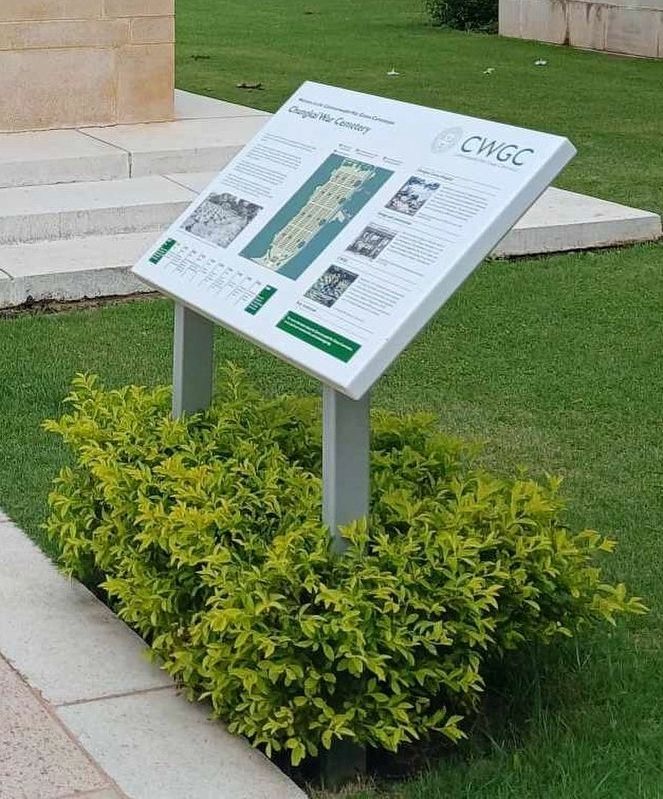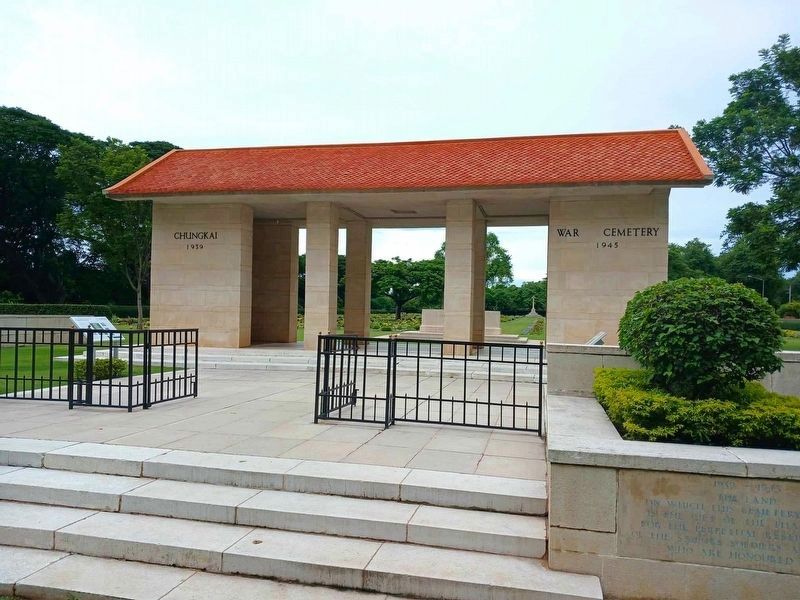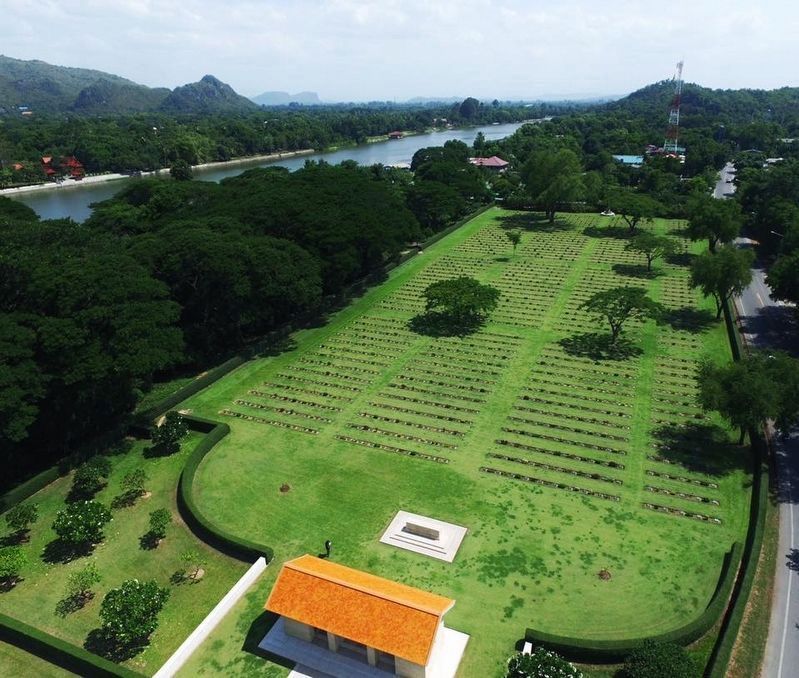Tha Ma Kham in Amphoe Mueang Kanchanaburi, Kanchanaburi, Thailand — ประเทศไทย (Southeast Asia, Indochinese Peninsula)
Chungkai War Cemetery
1939 – 1945
— CWGC — Commonwealth War Graves Commission —
Inscription.
Welcome to the Commonwealth War Graves Commission Chungkai War Cemetery.
During the Second World War tens of thousands of Commonwealth, Dutch and American service personnel became prisoners of war (POWs) of the Japanese.
In 1942, the Japanese ordered a 250-mile railway be built through the mountainous jungles of Thailand and Burma. Work camps for POWs and labourers were made along the proposed route, including one here called Chungkai Camp, where the POWs were allowed to build a theatre, church, hospital and cemetery.
At the height of railway construction more than 60,000 POWs worked alongside 200,000 forced local labourers; all suffered from malnutrition, disease and mistreatment. By the time the line was completed more than 12,000 POWs and as many as half of the local labourers had perished.
After 1945, the cemetery here was expanded when the remains of Commonwealth and Dutch servicemen were brought from along the southern half of the railway, from Bangkok to Nieke. Today, more than 1,400 Commonwealth and 300 Dutch servicemen are buried here.
Chungkai Camp Hospital. Established as a work camp, Chungkai also served as transit hub for thousands of POWs travelling up the line to work. The POWs living here established a rudimentary hospital with an operating theatre so they could treat their sick and injured comrades. This grew to become one of the main POW hospitals in Thailand, where 20 large huts housed up to 2,000 men at any one time.
Design and construction. After the surrender of Japan in 1945, this cemetery was passed to the War Graves Commission to ensure its continuing care. The architectural features of the cemetery were designed by Colin St. Clair Oakes, who fought in the jungles of Burma during the war and was the principal Commission architect in Southeast Asia.
CWGC. Established in 1917, the Imperial (now Commonwealth) War Graves Commission commemorates more than 1.7 million dead of the two World Wars. Our founding principle is to honour each person equally, regardless of rank, race or religion. In Thailand the CWGC commemorates more than 8,700 service personnel here and at the nearby Kanchanaburi War Cemetery.
Timeline. 1917, May — Creation of the Imperial (now Commonwealth) War Graves Commission • 1939, Sept. — British Empire enters Second World War • 1941,Dec. — Japanese forces launch offensive in Southeast Asia • 1942, Feb. — Commonwealth forces in Singapore surrender to the Japanese • 1942, June — Work begins on the Thai-Burma Railway • 1943, Oct. 7— Railway Completed • 1944 — Japanese forces defeated in India • 1945, Aug. — Japan surrenders, End of the Second World War • 1948 — Last burials made here • 1954 — Construction of cemetery features begins
Erected by
the Commonwealth War Graves Commission.
Topics and series. This memorial is listed in these topic lists: Cemeteries & Burial Sites • War, World II. In addition, it is included in the The Thailand-Burma Railway series list. A significant historical year for this entry is 1942.
Location. 14° 0.345′ N, 99° 30.908′ E. Marker is in Tha Ma Kham, Kanchanaburi, in Amphoe Mueang Kanchanaburi. Memorial is on 3228 Road (Bannua Road), 2.1 kilometers south of Sangchuto Road (State Route 323). Touch for map. Marker is at or near this postal address: 1939 3228 Rd, Tha Ma Kham, Kanchanaburi 71000, Thailand. Touch for directions.
Other nearby markers. At least 8 other markers are within 3 kilometers of this marker, measured as the crow flies. Takashi Nagase (Fujiwara) (approx. 2 kilometers away); The JEATH War Museum (approx. 2 kilometers away); The Tomb of 10,000 Souls (approx. 2.9 kilometers away); Memorial to Dutch Prisoners of War (approx. 3 kilometers away); Tribute to Royal Dutch East Indies Army and the Royal Netherlands Navy Personnel Who Perished (approx. 3.1 kilometers away); That Valiant Company Who Perished While Building the Railway (approx. 3.1 kilometers away); Kanchanaburi War Cemetery (approx. 3.1 kilometers away); The Kanchanaburi Memorial (approx. 3.1 kilometers away).
More about this marker. This interpretive panel is to the left of the entrance gate building. A matching panel on the right is in the Thai
language.
The panels include five images. Clockwise from lower left: “Chungkai War Cemetery at the end of the War,” a 1945 photograph in the Australia War Memorial collection. • a diagram of the cemetery • 1943 “Painting of Chungkai Hospital” by Jack Chalker in the Australia War Memorial collection. • “Chungkai War Cemetery entrance building under construction,” a 1955 photograph in the Commonwealth War Graves Commission collection. • a contemporary photograph of two visitors at the cemetery attributed to Brian Harris.
Also see . . . Wikipedia Entry. Excerpt:
The cemetery at Chungkai hosts the graves of 1,426 British and 313 Dutch servicemen who died during World War II. The majority of the interred died building the sections of the nearby Burma Railway. The cemetery is built on the site of a prisoner of war camp used by the Japanese army to house Allied POWs during the conflict.(Submitted on August 7, 2023.)
Additional commentary.
1. This cemetery is on the site of a prisoners of war camp
The ChungKai CWGC cemetery is at the site of the Thai-Burma Railway ChungKai prisoners of war (POW) camp. This cemetery is the only one of the three that hold Thai-Burma Railway remains that was an active cemetery during the war. The other two — Kanchanaburi and Thanbyuzayat — are collection
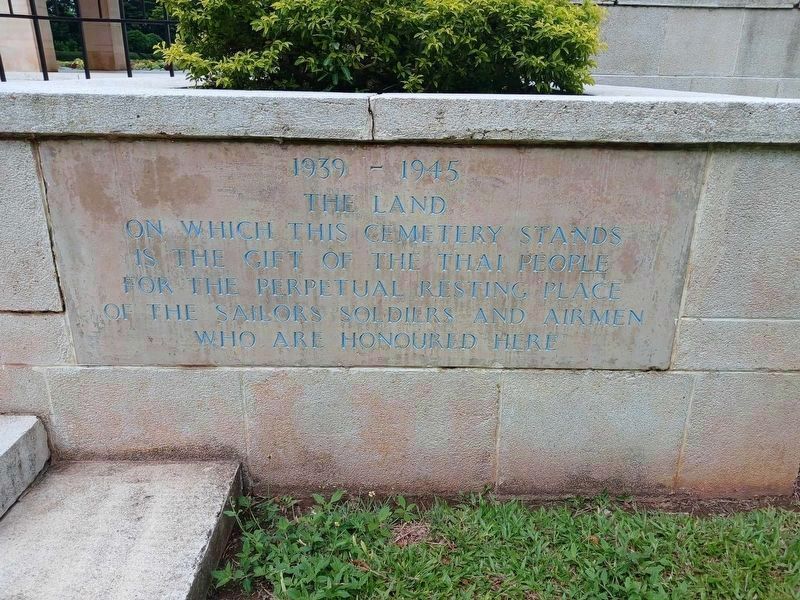
Photographed By Jj Karwacki, August 4, 2023
4. Flanking the Steps to the Entrance
On the right, in English; on the left, in Thai. Refer to photograph No. 2 for exact location. It reads,
1939 – 1945
The Land
on which this cemetery stands is the gift of the Thai People for the perpetual resting place of the sailors, soldiers, and airmen who are honoured here.
The ChungKai POW camp at kilometer 60 of the Railway was the first actual POW work camp. The earliest arrivals in October 1942 were mostly British Army Officers. Many of them had been the cadre of Indian Army units who had been separated from their men in Singapore. There was an initial resistance on the part of the officers to do manual labor. The machine gun scene from the Bridge on the River Kwai movie is thought to have been based on that confrontation.
The ChungKai camp was quite unique in many ways. It was a microcosm of the entire Railway project. In addition to laying tracks from the Mae Klong bridges, these men encountered the first of many limestone outcroppings that required what is generally referred to as a ‘cutting’. Using only a hammer and chisel, holes were drilled then filled with explosives to blast away the rock until a path was carved through the rock. There were two of these cuttings needed at Khao Poon. But first they had to move dirt to make a 10m high ‘fill’ to level the ground along the river bank. Beyond the cuttings, a moderate-sized bridge spans a ravine. It is still known today as the “Officers Bridge”. Filling, cutting and bridge building were how the Railway was constructed.
Once the work in this area was complete, the men were marched to new camps farther along the Railway. Because of its strategic location at the mouth of the Kwae Noi River, rather
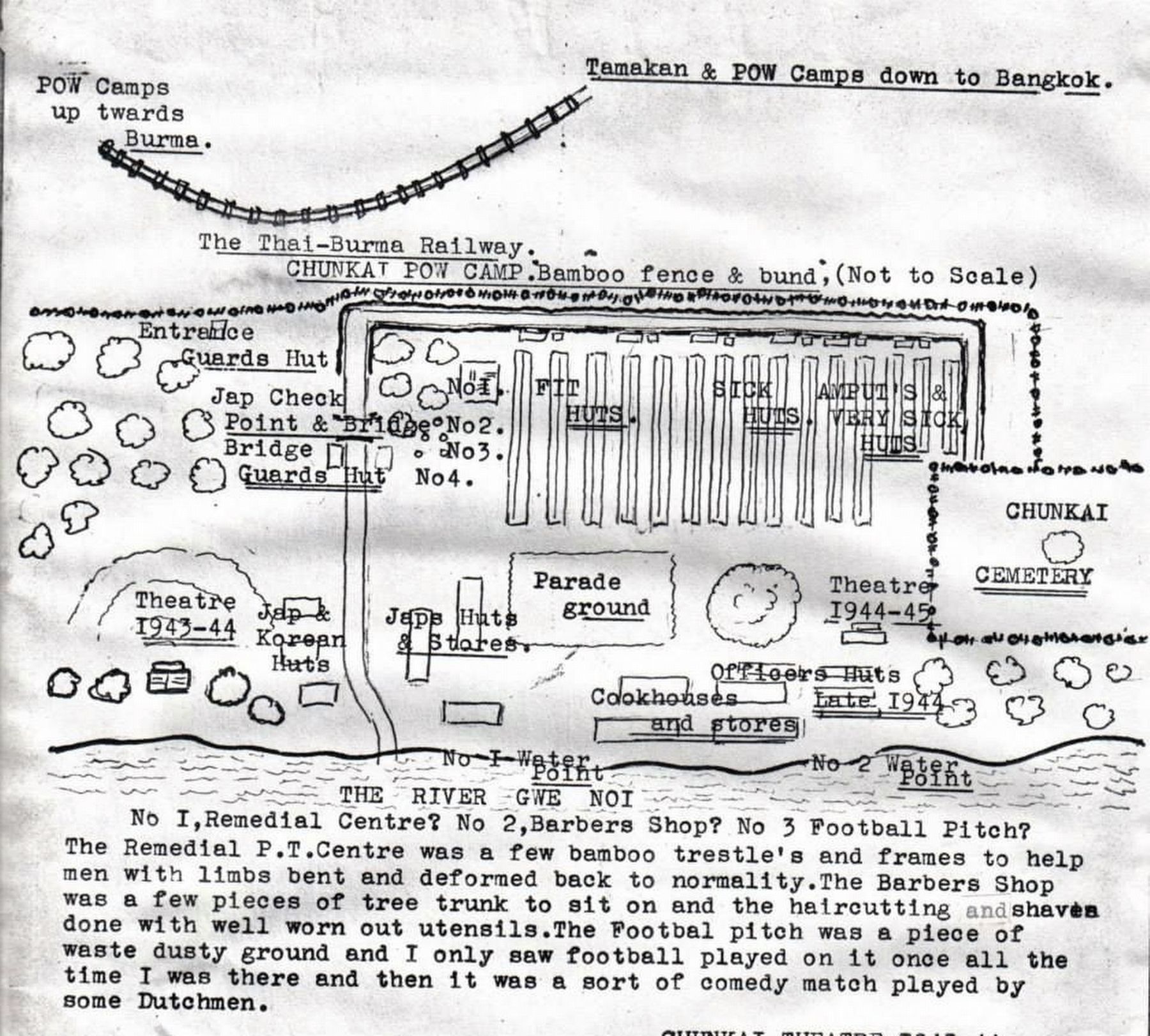
In the collection of Jj Karwacki
5. Chungkai POW Camp Diagram
The text at the bottom reads,
No. 1. The Remedial P. T. Centre was a few bamboo trestles and frames to help men with limbs bent and deformed back to normality. No. 2. The Barbers shop was a few pieces of tree trunk to sit on and the haircutting and shaves done with well worn out utensils. No. 3. The Football Pitch was a piece of waste dusty ground and I only saw football played on it once all the time I was there and then it was a sort of comedy match played by some Dutchmen.
The common myth is that the graves seen there today are of those who died there. While that is true for many, it is not exclusive. Some other remains were interred there post-war and all of the Australian remains were shifted to Don Rak. The exact process by which this occurred is not fully understood.
What exists today as the CWGC War Graves Cemetery is but a small part of the camp that ran for nearly a kilometer along the riverbank. There are just over 300 Dutch POWs interred here. In addition, there are 3 non-POW graves of Dutch citizens added in 1946. Among them is the only other woman in these cemeteries (there is a single grave of a British woman at Don Rak). Apparently Agnes M. Mende was a 25yo clerk working for the DEI Navy. She is said to have died a ‘heroic death’, at the POW hospital in Nakorn Pathom, but little more is known of her story. The other two were elderly gentlemen.
— Submitted August 7, 2023, by Jj Karwacki of Tha Maka, Kanchanaburi.
2. Number of POW Burials
British 1377
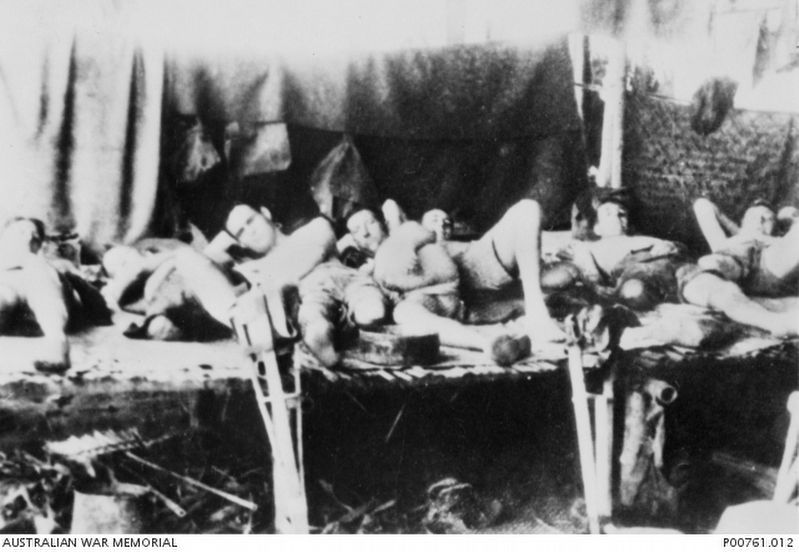
(Public Domain) in the collection of the Australia War Memorial. Image No. P00761.012, circa 1943
6. Amputation Ward in a Bamboo Hut Hospital
Caption: “Burma-Thailand Railway. c. 1943. ‘Amputation ward’ in Bamboo Hut Hospital at a prisoner of war (POW) camp along the Burma-Thailand railway. The POWs have mostly had legs amputated because of uncontrollable tropical ulcers. (Photograph donated by A. Mackinnon.)”
In addition to the POWs, there are a small number of post-war (non-POW) graves including one Dutch woman who died at the NakornPathom Hospital in 1946.
— Submitted August 19, 2023, by Jj Karwacki of Tha Maka, Kanchanaburi.
Credits. This page was last revised on August 29, 2023. It was originally submitted on August 7, 2023, by Jj Karwacki of Tha Maka, Kanchanaburi. This page has been viewed 141 times since then and 12 times this year. Photos: 1, 2, 3, 4, 5. submitted on August 7, 2023, by Jj Karwacki of Tha Maka, Kanchanaburi. 6. submitted on August 7, 2023, by J. J. Prats of Powell, Ohio. • J. J. Prats was the editor who published this page.
